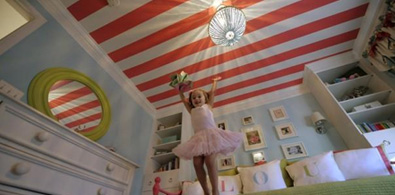
While a home is where a family bonds, and grows, and squabbles, and shares, and connects, we all know it’s important to have a space within this realm to call one’s own. This is especially so for children. Although it may seem that their stuff often migrates to the far reaches of each corner of every room, kids need a space to call their own on which they can stamp their own décor identity.
But for any parent with a distinct notion of the décor direction of your home, how do you allow your child expressive freedom in their room without having to constantly close the door when you walk by if their design sense is in complete contrast to your own? Just remember one key word: compromise. And follow the mantra of spending wisely, both with your time and money, for tastes and fads change and fade.
Here are a few more words to help you with creating a space that speaks to your child’s character and works within your design sensibility and budget.
Lead – As with anything in life that you are guiding your child through, you can help lead them in a constructive direction when it comes to the décor of their room. Form follows function is a great starting point, recognizing that most kids’ rooms serve multi functions and need to be practical. And then start with their interests, favourite colour, or character in a book, or family trip as a launching point for the theme or scheme of the room.
Involve – Rather than dictating your preferences or allowing your child cart blanche decision making, narrow down the choices of themes, colours, finishes, and details to a few that resonate with your child yet work within your design direction.
Invest – Spend your money wisely on the ‘big ticket items’ on pieces that will grow with child. Or shop in thrift stores, garage sales, and online for second-hand pieces that aren’t too expensive and that you won’t feel badly parting with once that fad or need has passed.
Neutralize – Create a neutral base for the room with furniture that is a neutral colour or with an unobtrusive wall colour, especially if your time is dear. However, paint is cheap and relatively easy to change over time should your child change his or her mind.
Accessorize – If a child wants a colour that is out of whack with your home’s colour palette, introduce the offending shade through accessories such as throw cushions, rugs, art, drapery etc.
Display – Complete the personalized look of their room with their own school art or favourite collection of trading cards, or stuffed animals, or sports accessories and memorabilia, or travel interests. Hang and displaying this ‘art’ on the walls or on shelves at a height at which they can appreciate the pieces, especially effective with younger kids.
Let it go – As with other areas of their lives, it’s important to pick your battles. Look at what they are asking for and ask yourself if it is a deal breaker. Many parents may feel, for instance, that black walls is a no no, but maybe one feature wall is enough for your child, and something you can live with. If they want to tack up posters of their latest heartthrob, as long as they don’t irreversibly damage the walls, you may just want to let them.
Just remember what it was like to be a kid yourself, and how important it was to express the personal identity you were striving so hard to develop. Allowing your child to put their personal stamp on their rooms is a part of helping them to develop their unique character.
Susan Forint is connected with the design sense of the youth of today through her niece and three nephews and through her personal connections with parents and kids navigating the décor dilemmas and debacles they face.
Susan, educated in interior design and business, has followed a dynamic career path in design, marketing, communications, events, and social media. Her own lifestyle blog, saf affect, focuses on décor with a thrifty, sustainable perspective, sharing her passion for affordable and inventive design.



